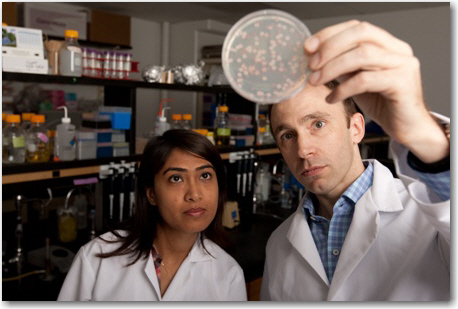Team Effort Between UH, Michigan State May Lead to Strategies to Reduce Antibiotic Resistance

In collaboration with scientists at Michigan State University (MSU), UH evolutionary biologist Timothy Cooper and his graduate student Utpala Shrestha were co-authors on a paper titled “Second-Order Selection for Evolvability in a Large Escherichia coli Population.” The report appeared March 18 in Science, the world’s leading journal of original scientific research, global news and commentary.
“The project found that bacteria growing for thousands of generations in an environment containing glucose as the only food had evolved to be better at getting better,” Cooper said. “We found that two lineages of bacteria arose and competed in a single experimental population. The lineage that initially grew more slowly, yet had the potential to evolve more rapidly, was the evolutionary ‘winner.’ This is surprising because it’s usually thought that competition is decided by what competitors can do now and not what they are capable of in the future.”
As genetic changes occurred, making some individuals better competitors on the glucose food, other individuals that did not quickly get their own beneficial mutations were outcompeted and went extinct. Down the line, understanding the benefits of evolving quickly like this will be a useful tool to predict such things as antibiotic resistance and the evolution of infectious disease. Cooper said this knowledge may one day help scientists design intervention strategies that make the evolution of these traits less likely to occur.
The work done by Cooper and Shrestha at UH established the specific genetic changes occurring during this bacterial evolution experiment that caused the change in their ability to evolve further. They discovered the genetic change that was important for determining which bacteria would prevail and which were destined to become extinct.
“Our collaborators isolated individual bacteria from a population that had evolved for 500 generations and sequenced their entire DNA genome to determine all the changes that had occurred,” Cooper said. “By isolating these changes and adding them in defined combinations back into the original ancestral strain, we were able to determine their individual effects.”
Reminiscent of Aesop’s lesson that ‘slow and steady wins the race,’ Cooper adds that even bacteria can benefit from a long-term view, with their experiment showing that bacteria that adapted, slowly but consistently, outcompeted those that initially grew quickly but then ran out of ways to improve.
With much of his work based on experimental evolution, which is the lab-based study of evolving populations, Cooper’s motivation for this experiment comes from wanting to understand the factors involved in evolution of organisms to better fit their environments. Using bacterial and computational experimental systems he aims to identify and integrate these mechanisms and examine how they depend on genetic and environmental factors.
“Bacteria provide an ideal model system to address these questions, because they evolve so quickly, undergoing thousands of generations in only a few years,” Cooper said. “Additionally, we can now sequence their entire genomes and determine the genetic changes that lead to improvements in their ability to grow.”
Funded by the National Science Foundation and the Defense Advanced Research Projects Agency, this work was a multidisciplinary effort done in collaboration with researchers in zoology, microbiology and molecular genetics at MSU. In addition to UH’s Cooper and Shrestha, the MSU team consisted of Richard Lenski, Jeffrey Barrick, Robert Woods and Mark Kauth. Woods has since moved on to the University of Michigan and Barrick is currently at the University of Texas at Austin.
- Lisa Merkl, University Communication